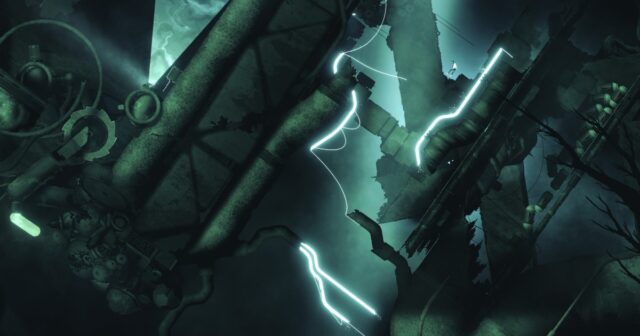I don’t envy anyone trying to make a great 2D puzzle platformer in 2025. It’s a very crowded genre, and sometimes it can feel like there aren’t many more ways to spin it into something new. Games like Neva and Planet of Lana are gorgeous, but neither breaks new gameplay ground. It’s a high ceiling to reach if you’re looking to do something new, but Bionic Bay gets it done in impressive fashion.
At a glance, the new game from publisher Kepler Interactive checks a lot of boxes. It’s a moody tone piece that looks quite a bit like Limbo. The adventure takes players through a gantlet of 2D levels steeped in biomechanical mystery. Levels are creepy and full of well-placed traps that lead to countless deaths. Where Bionic Bay sets itself apart from dozens of games with that description, though, is a an ingenious item swapping puzzle hook and a speedier pace that’s usually reserved for speed-focused action games. Those two pieces are enough to make it one of the tightest games of its kind I’ve played so far in the 2020s.
Like Limbo, Bionic Bay is minimalistic in its storytelling. All I really know is that I’m a man in some kind of factory. Is it a human one or am I on some sort of alien planet? I have no idea, but what I do know is that I’m surrounded by danger. Levels are dark and moody, building off of the same tone that PlayDead pioneered in games like Inside (and later brought to new studios with Somerville and Cocoon). Each level feels daunting, with my miniscule character climbing on giant machinery and silhouetted against by harsh lighting. Every frame is a painting here, as developer Psychoflow Studios leans into monochromatic vistas that feel both mechanical and otherworldly.
That’s the “easy” part of making a puzzle platformer (which isn’t very easy at all). The tougher challenge is making something that doesn’t just play like everything else that paved the way for it. That’s where Bionic Bay excels. The bulk of it is built around a swap function. When I see an object, I can press a button to mark it. When I press another button, I change positions with it. It’s a simple idea, but one that Psychoflow Studios gets a lot of mileage out of. I can use that power to get through a narrow hallway by swapping with the box that’s blocking it. It opens the door for physics puzzles too, in which I launch an object up to a high platform and switch with it at its height to get to where I need to go. That idea makes for some good slapstick deaths too, as I often wound up crushing myself by swapping underneath a falling tower of crates. It’s a great idea that’s always iterating as each level goes on, putting it in the vein of something like Portal rather than Limbo.
That isn’t the only trick in its playbook, either. Later, I get a time-slowing power that lets me safely move through fast moving fan blades and buzzsaws. In a few levels, I gain the power to smash objects into the distance with an energy punch, something that combines with my other powers. Some standout puzzles have me slowing time, punching a sheet of metal, jumping on it, and then riding it across a gap. Bionic Bay covers a lot of ground in around 10 hours, and that’s a tough thing for a minimalistic platformer like this to pull off.
What I appreciate even more than all that is the speed at which it all unfolds. Whereas games like Limbo tend to be slow and lurching, Bionic Bay has an energy closer to Katana Zero. In the early levels, I’m running, air dashing, and solving puzzles without stopping. I only find myself slowing down once I get into the second half of it, as some puzzles become more complex. It’s a great pace for a game like this that gives players space to figure out position swapping puzzles on the fly rather than relying on brainy set pieces that require careful spatial reasoning and experimentation to nail.
That pace is intentional, as Psychoflow Studios encourages players to speed through it. Bionic Bay features an online mode where players can race through levels and try to set high scores on leaderboards. It’s the kind of feature that you usually wouldn’t find in something like this, emphasizing how much it wants players to move and solve puzzles fluidly.
As someone who has grown a little tired of games like this, Bionic Bay revitalizes my appreciation of the 2D puzzle platformer. It’s familiar in tone and style, but I love the way that it turns brainy puzzling into something pulse-pounding. It feels like an action game, even when I’m just swapping my position with a crate to avoid some lasers. A small twist like that is all the genre needs sometimes to feel new again.
Bionic Bay launches on April 17 for PS5 and PC.

















































